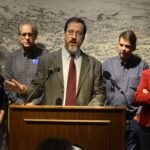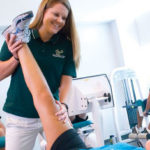Students till their student community garden with promise
While other students slept in or headed for the beach on a recent Friday morning, members of the University of West Florida Community Garden Club worked up a sweat installing an irrigation system for the newly planted Student Community Garden located just behind the soccer field on the main campus.
With four raised cypress-sided beds currently standing and several more planned, the Student Community Garden is filled and tilled with promises — of fresh beans, squash, corn, sweet orange peppers and a variety of herbs. Pumpkin seeds have been planted on the hill behind the garden where wild treasures such as onion and blackberry bushes have been spotted.
The garden is the tangible result of the Student Community Garden Club working in partnership with campus administrators and with students from “The Politics of Food,” an Honors seminar taught by UWF professor Greg Tomso. Members of the Progressive Student Alliance and the Student Environmental Action Society have also been instrumental in creating the garden. The students believe that most food production and consumption in the modern agricultural industry is not done in a healthy manner, for people or the environment.
“We want to work to change that, by doing something really proactive and positive,” said Hilary Turner, one of more than a dozen students involved in the project. “We hope to inspire people in our community to take their food literally into their own hands. If we could spark others to start more gardens, that would be amazing. We want to see more come out of this garden than just food.”
As a group, the students knew little about gardening a few weeks ago, but research, hard work and trial and error are helping their garden thrive. Already reaching toward the sun are sturdy sunflower, tomato and soybean plants. Anne Swisshelm said one bed sports the “ancient” gardening system called “three sisters” where a corn, beans and squash are planted together. In another bed, they intend to use the “square-foot gardening” idea, according to Turner.
Shovel in hand, David Lee, president of SEAS, explained the drip irrigation system he and others were installing to feed the beds, which are 24 feet long, 4 to 5 feet wide and about 2 feet tall. Right now, the water supply is a nearby spigot, but eventually rain barrels will collect what the garden needs.
The garden is entirely organic and the students are using recycled materials when possible. For example, the cypress for the beds is scrap wood from a local mill. Asa Furman, an Honors student and the group’s unofficial engineer, designed and built the nearby composting system using three empty 55-gallon drums and surplus lumber. He monitors the drums’ contents to maximize breakdown. The compost material will feed the garden, just as the garden’s waste will feed the compost system.
Members of the Student Community Garden Club, which Swisshelm started last year, also work the garden. The club, open to all UWF students, faculty and staff, meets Tuesdays at 5:30 p.m., in Building 22, Room 268, and Fridays at 10 a.m. at the garden site.
According to Tomso, the garden’s faculty advisor, the site’s future plans include more beds for more vegetables and fencing to keep out unwanted visitors such as hungry rabbits. He also envisions different campus groups getting involved, perhaps sponsoring their own garden bed.
But for right now, only those students working regularly in the garden will enjoy its yield.
For more information, contact Greg Tomso at gtomso@uwf.edu. For information about the Student Community Garden Club, contact Anne Swisshelm at ams67@students.uwf.edu.
By Susie Forrester, University Marketing Communications


